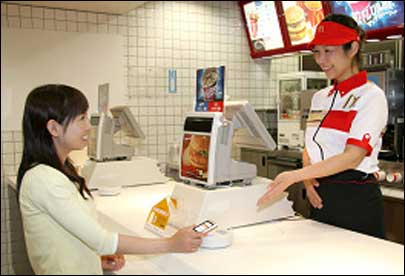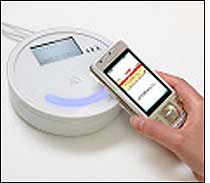McDonald’s Holdings Japan, Inc. has launched a pilot enabling customers to use RFID technology to receive and redeem discount coupons over their cell phones. The phones are equipped with a near-field communication (NFC) RFID tag containing a Sony FeliCa chip that allows the handsets to be used as mobile payment devices, as well as to download coupons for use at McDonald’s restaurants.
On May 20 of this year, 175 McDonald’s restaurants in the Kyushu area of Japan began offering the service. By July 2009, the restaurant chain expects to expand the coupon system to include the country’s other 3,800 McDonald’s restaurants.
The system is built on NTT DoCoMo‘s Osaifu-Keitai platform for mobile-wallet services, which has enabled Japanese consumers to use an NFC FeliCa chip in their phones for the past three years to pay for transit fare at train stations, and to make purchases at participating stores. In the past, phone operators could utilize the Osaifu-Keitai platform and the FeliCa chip to pay for meals at a McDonald’s point-of-sale (POS) terminal. Now, they can also use their phones to download coupons specific to their buying preferences, thereby eliminating the need to clip out or carry paper coupons.
McDonald’s Japan launched the system as an alternative to television and newspaper advertising—a market which the company says has been dwindling lately as a more diversified Japanese audience spends less time in front of the television, and is easier to reach via their phones than any other medium.
In July 2003, McDonalds first launched its cellular Web site—accessible from mobile phones—and an e-mail newsletter, which it releases every Friday with new promotions for products. Now, each pilot participant will also receive coupons based on their purchase history at McDonald’s, after they install the necessary software onto their phone. They can then select specific coupons by scrolling over the options, and make a purchase at the restaurant’s POS terminal by tapping the phone next to the device and receiving the selected discount. The payment can then be either automatically deducted from the user’s bank account, or billed later in a credit card statement.
At a press conference held May 20 in the city of Fukuoka, McDonald’s Japan’s senior officer and director, Nobukazu Maeda, stated that payment using a Kazasu Kuupon (contactless coupon) at the point of sale, rather than a coupon clipped from a newspaper, would make the payment process about 10 times faster, according to a news article published online by ITmedia. For customers, the times saving would be even greater since there would be no coupon clipping at all.
If they prefer, customers can also pay for a meal in cash but still utilize the coupons on their mobile phone. To do so, they would need to indicate to a McDonald’s employee that they wish to pay by cash.
To join the Kazasu Kuupon program, pilot participants must download and fill out an application online, or on their phone, and submit it to McDonald’s Japan’s. They can then begin receiving the digital vouchers on their phones on a regular basis.
“This sort of promotion is dependent on a country having a high percentage of 3G [third-generation] telephony,” says Liam Jeory, corporate relations VP of McDonald’s Asia-Pacific, Middle East and Africa (APMEA). This, he notes, would require a much higher level of cell phone functionality than currently exists outside of Asia. “This sort of technology enables many uses, including better Internet access and the ability to use the phone as a cash card and pay for items by simply swiping the cell phone, automatically deducting cash from a balance.”
Additionally, McDonald’s Japan is allowing pilot participants to read bar codes attached to the food items they purchase. A participating customer uses the phone’s camera to capture the food’s bar code and access the section of the McDonald’s Web site listing that item’s nutritional information. “Our Japan team is always looking for other ways of leveraging this technology—hence the couponing,” Jeory says.
McDonald’s Corp. does not intend to launch a similar pilot in North America, according to a company spokesperson in the United States.



